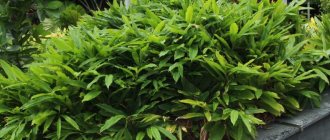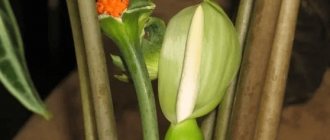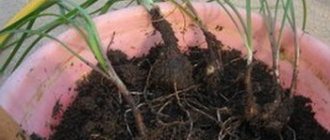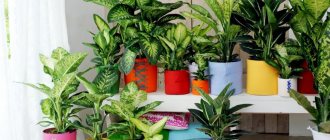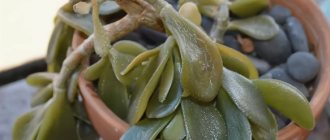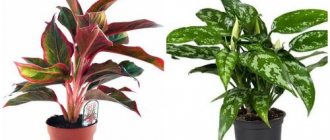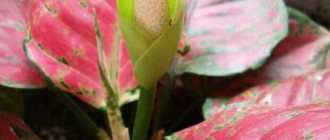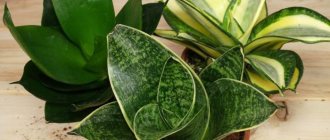Planting and caring for allamanda
- Flowering: from May to September, but only in conditions close to natural.
- Lighting: bright sunlight.
- Temperature: in summer – 20-25 ºC, in winter – 15-17 ºC.
- Watering: in spring and summer - plentiful, in autumn watering is gradually reduced, in winter water after the soil has dried to a depth of 3-4 cm.
- Humidity: high. The plant needs regular spraying. The flower is kept on a tray with wet expanded clay or pebbles.
- Feeding: mineral and organic fertilizers once every three weeks during the growing season. During the dormant period, do not feed.
- Dormant period: from late autumn to early spring.
- Transplantation: in spring: young plants - annually, adults - once every 2-3 years as needed.
- Support: The plant needs support, which is placed in the pot during transplantation. This could be an arch or a ladder.
- Substrate: 2 parts leaf soil, 5 parts humus, one part each of peat, sand and turf soil.
- Pruning: at the end of the growing season, the shoots of the plant are shortened by half. During the period of active growth, weak shoots are regularly removed.
- Reproduction: by seeds and almost lignified stem cuttings.
- Pests: nematodes, whiteflies, aphids and spider mites.
- Diseases: stem and root rot.
- Properties: allamanda has poisonous juice!
Formation of the crown and flowering of the alamanda at home
This liana has a phenomenal long flowering period, which, if you use additional lighting, can be extended throughout the fall.
Alamanda can be grown not only as a full-fledged liana and hanging crop, but also in the form of a bush. If you decide to grow this plant as a vine, you should not prune it, but you should provide it with support and tie up the branches. In other cases, formative pruning is indispensable.
The formation of the alamanda is carried out only after the start of the dormant period, most often this occurs at the end of November. All old, weak, thin, dying shoots are cut off, and young ones are pinched. Pinching young branches allows you to stimulate density and control the growth rate of the alamanda. If it is necessary to radically update and reduce the size of the vine, the shoots can be cut by a third or half of the height. Pruning is carried out above leaf nodes.
Trimming
Correct and timely pruning is the key to allamanda flowering. It should be carried out at the very end of autumn. All shoots are cut to half.
Advice. The plant needs support. Its shoots are weak and fragile, so they need to be tied up.
Allamanda care at home
Lighting
The best location for allamanda at home is windows on the south side, since it is light-loving and calmly tolerates a small amount of sunlight. Grows best in greenhouses or winter gardens.
Temperature
In summer, the temperature should be at 20-23 °C. From late autumn to late winter, the temperature is lowered to 15-17 °C, and watering is reduced. Drafts can harm the allamanda.
Watering allamanda
In summer, allamanda at home requires abundant watering, but care must be taken that the soil does not sour or dry out. In winter, water after the top layer of soil has dried.
Allamanda spraying
During the growing season, home allamanda needs to be sprayed regularly, as it prefers high air humidity. You need to spray carefully, avoiding water getting on the flowers to avoid reducing the decorative effect. It would be a good idea to place the pot of allamanda on a tray with wet expanded clay or pebbles.
Feeding allamanda
Fertilize the plant a little more than once a month during active growth, using organic and mineral fertilizers. Concentration is standard.
Allamanda pruning
At the end of autumn, in order for the allamanda flower to bloom more abundantly, it needs to be pruned. The shoots are reduced by half and cut off above the leaf nodes. During the growing season, weak shoots need to be pruned. The allamanda plant has weak stems, so they need to be supported.
Related article: Asparagus flower: home care, photos and types, propagation and transplantation
Allamanda transplant
Indoor allamanda is replanted after flowering - in the spring. Young specimens - annually, and adults - once every 2-3 years, if necessary. The soil mixture is made up of 2 parts peat and leaf soil, one part each of humus and turf soil, adding a little sand. Another option is 5 parts humus, 2 parts deciduous soil, and 1 part each of turf soil, sand and peat.
Allamanda from seeds
Allamanda seeds are sown in a moist mixture of equal parts peat and sand. Spray and ventilate, the temperature should be 23-24 °C. Shoots should appear within 20-40 days.
Allamanda propagation by cuttings
Almost woody cuttings of domestic allamanda are cut into pieces approximately 10 centimeters in length and planted in wet sand. In order for the cuttings to take root faster, they need to be treated with growth stimulants and provided with bottom heating. It is necessary to regularly spray and ventilate, the temperature is kept at 23-24 °C. When the cuttings take root, they are planted in a mixture of sand, humus and turf soil (1:1:1). After a month and a half, they begin to care for them like adult specimens.
Allamanda toxicity
The sap of the allamanda plant is poisonous, so after working with the plant you should wash your hands with soap. There is a great danger of juice getting on the skin when transplanting and propagating allamanda.
Reproduction
Alamanda is most often propagated You can also grow plants from seeds.
Seeds must be sown in light nutrient soil based on sand and peat. The soil and air temperature must be maintained at + 24°C. After a while, when the young seedlings get stronger and grow, they should be transplanted into separate containers.
pots as for alamanda. This will help maintain soil moisture and passively regulate it.
Cuttings are prepared in early spring. New sprouts of vines, which have 3-4 young leaves, are chosen as young specimens. Next, the cuttings are transferred to the ground and kept at a stable temperature and high humidity in a mini-greenhouse.
The only caveat is that they need to be placed in a substrate with a high temperature - +22+24°C. The soil should be well heated throughout the plant's growth.
Propagation by seeds
Allamanda plants are propagated by seeds in late winter - early spring, but no later than mid-March. First, the seed is kept in a solution of potassium permanganate for 10 - 12 hours. After this, wash and dry. Prepared seeds are planted with a light substrate at a distance of 3 - 4 cm from each other. Sprinkle a layer of sand on top, moisten with a spray bottle, and cover with polyethylene to create greenhouse conditions. Keep in bright, diffused light and a temperature of 22 - 25 degrees. The crops are ventilated daily and periodically moistened. In 1.5 – 2 months the sprouts will hatch. After this, the shelter is removed. When the third leaf appears, young plants are planted separately.
Propagation by cuttings
In the spring, cuttings of 9–12 cm long are cut from lignified shoots. They are planted, after having been kept in a growth stimulant, in a substrate of peat soil and sand. Cover the top with a cap made of a glass jar or plastic bottle. Contain in the same conditions as the seeds. When foliage appears, which will indicate the rooting of the cuttings, you can transplant it into regular soil in a permanent place.
Allamanda diseases and pests
Allamanda is rotting. The base of the allamanda stem may turn black and begin to rot if the soil is too wet or the seeds are sown too close to each other. For these reasons, Allamanda may develop blackleg disease.
Allamanda's leaves are turning yellow. Insufficient light or lack of nutrients can cause the plant to grow stunted, stems to stretch, leaves to yellow, or blooms to be poor.
Allamanda leaves turn brown and curl. Due to drafts and cold air, as well as excess moisture, the leaves turn brown and curl. It is necessary to reduce watering and keep the temperature at the recommended level.
Allamanda pests. The main pests are whiteflies, nematodes, aphids and spider mites.
Problems during cultivation
- Alamenda withers and droops in the summer with insufficient watering, in winter, on the contrary, if the watering is too abundant and/or the temperature is too low;
- Yellowing of the foliage and stretching of the shoots indicates that the plant does not have enough lighting or there are insufficient nutrients in the soil;
- Leaves curl and change color when kept in too low temperatures;
- Leaves turn brown at low temperatures, dampness and excessive soil moisture;
- Alamanda sheds its leaves when exposed to cold drafts and waterlogged soil;
- Blackening of the plant indicates the beginning of rotting, which occurs when the soil is waterlogged in combination with low temperatures. The plant needs to be renewed by re-rooting the cuttings.
Views: 995
Types of allamanda
Allamanda nobilis
Allamanda laxative misc. noble (Allamanda cathartica var. nobilis). The shoots are reddish. The leaves grow up to 20 cm in length, sessile, lanceolate, pointed at the apex; the underside of the leaf platinum is pubescent; two or three pieces grow from nodes. The flowers are yellow with a pale spot in the throat; up to 12 cm in diameter, smell pleasant.
Allamanda hendersonii
Allamanda laxative misc. Henderson (Allamanda cathartica var. hendersonii). This species grows very quickly. The leaves are leathery to the touch, collected in groups of three or four, thick. The flowers grow up to 12 cm in diameter, yellow-orange in color with pale spots (5 pieces) on the petals.
Allamanda grandiflora
Allamanda laxative misc. grandiflora (Allamanda cathartica var. grandiflora). Can be grown as a hanging plant, but grows slowly. The small leaves are lanceolate-ovate in shape. There are many flowers, growing up to 10 cm in diameter, lemon-yellow in color.
Allamanda Schottii / Allamanda schottii
Allamanda laxative misc. Schotta (Allamanda cathartica var. schottii). The shoots of this vine are pubescent, the branches are warty, and grow quickly. The leaves are collected in groups of three or four, lanceolate in shape. The flowers are yellow with brown stripes; pharynx – dark yellow.
Allamanda neriifolia
These shrubs grow to almost 1 m in height. Drooping shoots. The leaves are lanceolate-pointed or elliptical in shape, reach a length of 12 cm and are attached to short petioles; The upper side of the leaf is dark green, and the lower side is slightly lighter. Yellow flowers are attached to long stalks and grow up to 4 cm wide; the corolla tube is swollen at the base.
Allamanda cathartica
This climbing species is most often grown indoors. Grows in length up to 6 m. Leaves are arranged oppositely, large, elongated-ovate, bald (pubescent only at the bottom of the shoots along the veins), length - up to 14 cm, width - up to 4 cm. Flowers grow on the top of the shoots, large, up to 6 cm wide, funnel-tubular, yellowish in color, the base is whitish.
Violet Allamanda / Allamanda violacea
A climbing vine that grows slowly. The leaves are elliptical in shape, pubescent, up to 15 cm long, collected in groups of 4. At the tops of the shoots there are 2-3 flowers of a light purple hue.
Temporary pot and replanting
You can replant the perennial immediately after purchase. A temporary pot is not suitable for permanent cultivation of allamanda. This is best done in the spring. Some varieties grow vigorously and quickly develop roots from drainage holes. Such specimens will require an unscheduled transplant. There are some flowers that have to be replanted several times during the growing season.
Also, replanting is necessary if you constantly use running water for irrigation. Due to hard, non-melted water, the soil may begin to become saline. And this often becomes the cause of the death of an indoor flower. When choosing soil, it is best to give preference to compositions specialized for azaleas or conifers.
During transplantation, pruning is necessary. This is necessary to stimulate the active formation of new flowers. Most of the soil should be shards and sand, as the Allamanda prefers moist, but not waterlogged soil. The plant will have to be watered very often, so there is a risk of waterlogging the soil. In warm weather, the soil of indoor allamanda should dry out in no more than 4-5 days.
Description and features
Allamanda is an evergreen perennial that belongs to the Kutrov family. In fact, it is a liana-like or shrub plant with shoots that are flexible. Allamanda was brought from the American tropics. It should be noted such distinctive features as:
- the height of a shrub plant is up to 90 cm, a liana-like plant is slightly higher;
- pointed, elongated leaves in pairs, the color of lush green, the surface is glossy, shimmering;
- trumpet-shaped inflorescences have 5 petals;
- flower size – from 8 to 12 cm;
- possible shades of flowering are quite deep, bright: pink, yellow, cream, white;
- inside the stems there is milky white juice;
- poisonous plant everywhere
Botanical description of the plant
The culture is named after Leiden University professor Frederic Allamand. Its natural habitat is the tropics of South America, mainly Brazilian lands. It is a perennial evergreen crop of the Kutrovaceae family.
Allamanda grows in the form of trees, shrubs, and vines. It reaches a height of 2 to 10 meters. Thin shoots are flexible. Most species representatives have large, tubular-shaped fragrant flowers of yellow, purple, crimson, and coral shades. Each of the flowers has the shape of an opening bud and consists of five slightly protruding petals with a wider area.
All of them are collected in large inflorescences. When opened, their size is up to 12 cm. After flowering, prickly fruits in the form of boxes filled with a large number of seeds are located in place of the flowers. The oval leaves of the plants are placed in pairs, have a pointed tip, are smooth and rich, luxurious green in color with a shiny oily effect.
Allamanda blooms all summer and autumn. With proper care, abundant flowering is repeated year after year. The conditions of winter gardens and greenhouses with enormous spatial possibilities and significant air humidity are excellent for growing the crop. It is not so easy to grow allamanda in residential areas.
Varieties and varieties
There are quite a few species and hybrids of this representative of the flora. Flower growers identify several of the most common plants.
- Allamanda terry. The appearance of the inflorescence resembles a rose. The twisted petals have a distinct terry structure, are not smooth, with waves along the edges.
- Allamanda is laxative. A fairly common species, it climbs and can grow very tall, up to several meters. Naked, with fluff only at the bottom of the shoots, elongated oval foliage. Leaves are large. The flowers are yellow with a golden tint and a snow-white base and have a tubular appearance. There are many varieties in cultivation.
- Allamanda is noble. It is similar to the previous variety, but differs in lancet-shaped foliage and the shade of the shoots is reddish. The top of the leaves is sharp, the bottom is fluffy. The flowering is yellowish, large, with a pronounced, subtle aroma.
- Allamanda Henderson. It differs from its peers in appearance by its high growth rate and dense foliage, thickened type, with a leathery cover. Its foliage was collected in 3 or 4 sheets. Blooms in an orange hue with yellowness and light streaks.
- Allamanda grandiflora. It is distinguished by pinkish large flowers of a lemon tone. The inflorescences are arranged quite abundantly, the leaves are lanceolate, and the shoots are curling.
- Allamanda yellow large-flowered. It grows slowly, the shoots curl so that they can be grown as hanging plants. The leaves are oval and smallish. The flowering is bright yellow with a lemon tone.
- Allamanda Schotta. This is a fairly fast growing plant. The shoots are fluffy, the twigs are warty. Wide leaves are formed into 3 or 4 leaves. Flowering yellow-brown, striped.
- Allamanda is purple. Belongs to the slow-growing types. The foliage is elliptical in shape, pubescent, connected by 4 leaflets. The flowering is pale purple, the inflorescences are connected by 2-3 flowers.
Related article: Indoor abelia: care at home, photo and description, types: large-flowered
Where and how does a flower grow
According to the botanical description of the plant, shrubs are most often found in nature. They are distributed throughout the tropical forests of South America. Some gardeners grow allamanda at home or in greenhouses. Under such conditions, the perennial can be an evergreen vine with long woody stems. They climb and form a neat bush.
At home, allamanda practically does not bloom. This process is typical either for botanical representatives in the wild, or for those specimens that grow in greenhouses. For those gardeners who managed to get allamanda to bloom at home, the plant is not so spectacular and fragrant.
Home care
Before starting a plant, consider its location and lighting. Allamanda needs a lot of light, so the best option is a windowsill on the sunny side. Moreover, it should stand in close proximity to the glass; under no circumstances remove the plant from the windows, it will quickly wither.
The flower's love of the sun is combined with a fear of drafts, so be careful with ventilation.
The period of autumn and summer is the most comfortable for the plant; the air temperature in the room, as a rule, suits it. In the off-season, the temperature begins to decrease from +18 to +15 degrees in winter.
Moisturizing and feeding
Like many tropical plants, allamanda loves a lot of moisture during the growing season. Watering in spring and summer should be plentiful. It is necessary to ensure that the soil is not dry, but also not over-moistened, otherwise it will negatively affect the condition of the rhizome. Gradually reduce watering in the fall so that it becomes moderate by winter. During this period, the soil on top should have time to dry out from watering to watering.
Air humidity is one of the main conditions for the healthy development of allamanda. It is advisable that there is a hygrometer in the room where it is located. It will allow you to monitor the level of humidity, which should not fall below 60%. The plant loves water treatments, so spray the flower as often as possible in spring and summer. This can be done several times a day. In addition, periodically give the tropical beauty a moisturizing procedure on a tray filled with expanded clay, pebbles, moss or other humidifier. However, the water container should not touch the bottom. In winter, you can spray the plant several times a week.
We must not forget about feeding the plant during the spring-summer growth period.
You need to buy any universal fertilizer in special markets and carry out the procedure once a month. Dilute the product according to the instructions. The bush is pruned after it has flowered. The shoots are cut by about half, and dry flowers are removed. Dry or weakened shoots are removed throughout the year.
Transfer
The optimal time to transplant a green pet is spring. A plant that has not reached maturity is subjected to this procedure once a year. A mature shrub needs to be replanted once every 2 or 3 years. A very important point for planting and replanting is the correct soil. It should be loose, well-permeable and quite nutritious. The soil can be purchased ready-made or prepared independently by combining the following components:
- part of woody soil;
- part of the peat;
- two parts of leaf soil;
- two parts of humus soil;
- half a piece of sand.
All components are thoroughly mixed, after which transplantation occurs. If you have just bought a plant, it is advisable to immediately transfer it to nutrient soil. The planting algorithm is as follows:
- the pot should be slightly larger than the previous one;
- a drainage layer at the bottom is required; it is formed from any material: foam plastic, pebbles, broken bricks, expanded clay;
- then a small part of the soil is poured in;
- the plant is removed from the pot as carefully as possible, the soil is not completely removed from the roots;
- placed in a new container in the middle and covered with soil;
- the substrate next to the stem takes root;
- it is necessary to moisten the soil.
Diseases and pests
Despite the resistance to various types of diseases and insect attacks, it is necessary to pay attention to signs that indicate a violation of the health of the flower.
- If the neck of the rhizome begins to rot , this indicates waterlogging of the air and soil. It is necessary to treat with Fungicide as soon as possible.
- When the shoots lengthen, the stems become excessively elongated, and the foliage becomes pale and faded, it is worth paying attention to lighting and feeding. It is likely that the flower lacks nutrients and lighting. It is necessary to feed the flower and also ensure its exposure to the sun.
- The flower has begun to shed its leaves - you should check whether it is overcooled and whether the watering is too intense. The plant reacts to drafts in the same way.
- Insect attacks are quite rare, but do occur. If you notice an infestation of whiteflies or spider mites, take corrective action. It is necessary to give the plant a warm shower and treat it with special means - insecticides.
Sources:
https://floristics.info/ru/a-rus/allamanda.html https://zelenypodokonnik.ru/kutrovye/43-allamanda https://stroy-podskazka.ru/allamanda/vyrashchivanie/
Irrigation mode and air humidity
Allamanda does not like drought and can suffer greatly from drying out the earthen clod. During the spring-summer period of vegetative growth, follow the regime of abundant watering. But you shouldn’t get too carried away with water procedures. It’s better to wait until the top earthen ball dries out. In the autumn-winter season, watering is reduced to moderate. When the soil becomes waterlogged, rot begins to develop in the root system. For irrigation, use soft melt water without heavy impurities, especially lime. It is best to purchase bottled moisture for water procedures.
The air humidity in the room where allamanda is kept is of great importance. The humidity level is recommended within 60-70%. In the wild, the perennial grows along the banks of streams and spreads its seeds with streams of rain. Under no circumstances should air humidity drop to 30-40 percent when kept at home, as the leaves begin to turn yellow and dry out.
In the spring-summer season, nutrients are added every 7-9 days. For this purpose, mineral fertilizers are used for flowering plants.


